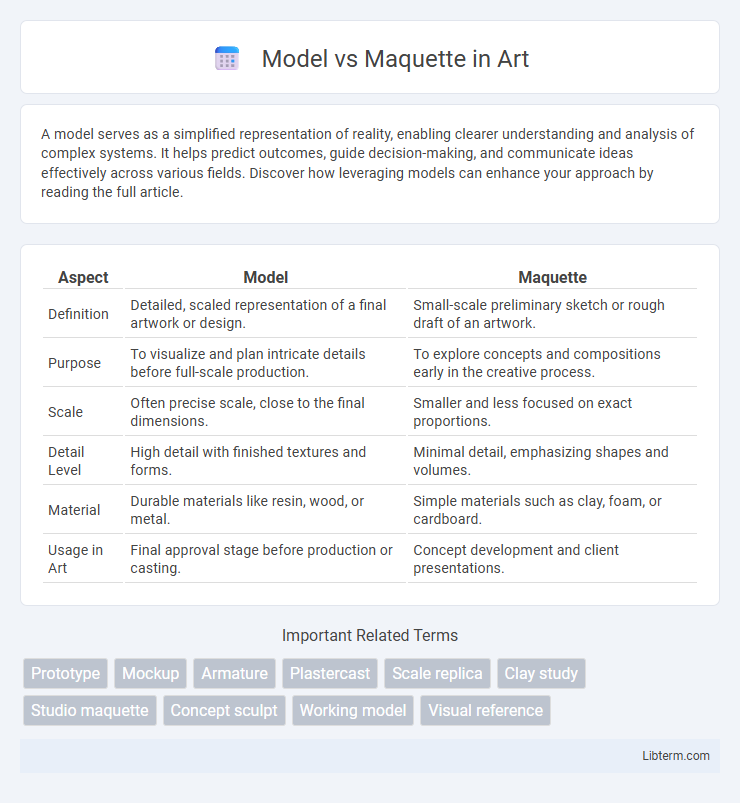A model serves as a simplified representation of reality, enabling clearer understanding and analysis of complex systems. It helps predict outcomes, guide decision-making, and communicate ideas effectively across various fields. Discover how leveraging models can enhance your approach by reading the full article.
Table of Comparison
| Aspect | Model | Maquette |
|---|---|---|
| Definition | Detailed, scaled representation of a final artwork or design. | Small-scale preliminary sketch or rough draft of an artwork. |
| Purpose | To visualize and plan intricate details before full-scale production. | To explore concepts and compositions early in the creative process. |
| Scale | Often precise scale, close to the final dimensions. | Smaller and less focused on exact proportions. |
| Detail Level | High detail with finished textures and forms. | Minimal detail, emphasizing shapes and volumes. |
| Material | Durable materials like resin, wood, or metal. | Simple materials such as clay, foam, or cardboard. |
| Usage in Art | Final approval stage before production or casting. | Concept development and client presentations. |
Introduction: Defining Model and Maquette
A model is a precise, often scaled, representation of an object or system used in engineering, science, or design to visualize, analyze, and test concepts. A maquette refers specifically to a small, preliminary three-dimensional sculpture or mock-up used by artists and designers to explore form and composition before creating the final piece. Both serve as essential tools in their respective fields, with models focusing on function and accuracy while maquettes emphasize artistic development and spatial understanding.
Historical Background of Models and Maquettes
Models and maquettes have roots dating back to ancient civilizations, where early Egyptians and Greeks used small-scale replicas for architectural and artistic planning. During the Renaissance, artists like Michelangelo relied on maquettes as preliminary sculptures to visualize larger works, while architects developed detailed models to refine structural designs. This historical evolution highlights the fundamental role of models and maquettes in bridging conceptual ideas and final creations across various creative disciplines.
Core Differences Between Models and Maquettes
Models serve as detailed, often functional or scaled representations used to test or demonstrate design concepts, while maquettes are small, preliminary sculptural studies primarily used to explore form and composition. Models emphasize accuracy and practical application in fields such as engineering or architecture, whereas maquettes prioritize artistic expression and visual brainstorming in sculpture and design. Core differences lie in their purpose, with models focused on precision and usability, and maquettes centered on creative development and idea iteration.
Purpose and Functionality: When to Use Each
Models serve as detailed, often digital or physical representations used for analysis, design validation, and simulation in fields like engineering and architecture. Maquettes, typically small-scale, handcrafted physical prototypes, function primarily to explore form, spatial relationships, and aesthetic qualities during early conceptual stages. Use models for precise measurements and performance testing, while maquettes are ideal for creative visualization and iterative design development.
Materials and Construction Techniques
Models commonly utilize lightweight materials such as foam board, plastic, or cardboard to allow for easy manipulation and rapid prototyping, while maquettes are often crafted from clay, wax, or plaster to enable detailed sculpting and textural exploration. Construction techniques for models emphasize precision cutting, assembling, and sometimes 3D printing to achieve accurate architectural or product representations, whereas maquettes rely more on hand-sculpting methods and layering to intuitively refine form and volume. The choice of materials and techniques directly influences the functionality of models for spatial visualization versus maquettes for artistic development and scale study.
Scale and Proportion: Impact on Design
The distinction between model and maquette significantly influences scale and proportion in design, with models typically representing full-scale or highly detailed depictions that allow precise measurement and spatial planning. Maquettes serve as smaller, conceptual three-dimensional sketches, helping designers explore overall form, balance, and visual impact before committing to accurate scale. Understanding this difference ensures appropriate tools are used for iterative design refinement and effective communication of dimensional relationships.
Applications in Architecture and Art
Models serve as detailed three-dimensional representations used extensively in architecture for visualizing spatial layouts and testing structural integrity before construction. Maquettes, smaller scale sculptures, are predominantly employed by artists and designers to explore form, composition, and conceptual ideas in a tangible format. Both tools enhance creative workflows, with architectural models emphasizing precision and functional planning, while maquettes focus on artistic expression and iterative design.
Advantages of Using Models
Models provide a dynamic and scalable representation of a concept or design, allowing for more detailed analysis and adjustments compared to static maquettes. They enable precise simulations and testing of structural or functional aspects, ensuring better accuracy and reducing costly errors in the development process. Utilizing models accelerates project workflows by facilitating improved collaboration and visualization throughout various stages of production.
Advantages of Using Maquettes
Maquettes offer tactile and visual advantages that enhance spatial understanding and design evaluation, allowing architects and designers to experiment with form, scale, and materials before final production. Their physical presence facilitates client communication and collaboration by providing a tangible representation of concepts that digital models may not fully convey. Using maquettes can also expedite design revisions through hands-on manipulation, reducing costly errors and improving overall project efficiency.
Choosing the Right Approach: Model or Maquette
Choosing the right approach between a model and a maquette depends on the project's detail level and purpose; models offer precise, scaled representations ideal for thorough analysis, while maquettes serve as rough, three-dimensional sketches primarily for conceptual visualization. Models emphasize accuracy and functionality, often used in engineering or architectural studies to test specific parameters, whereas maquettes prioritize artistic exploration and early-stage design feedback. Evaluating project needs, available resources, and end goals ensures selecting the most effective tool for visualization and development.
Model Infographic

 libterm.com
libterm.com